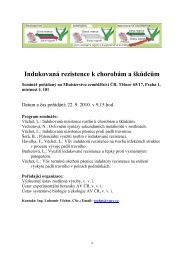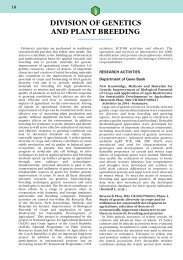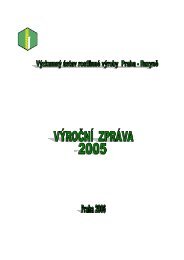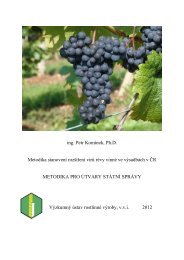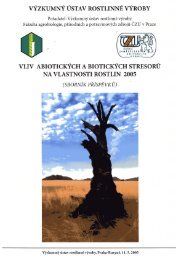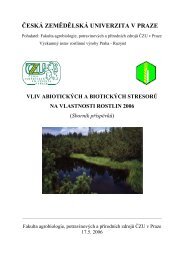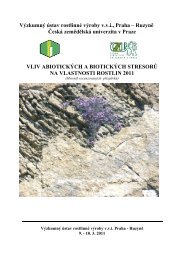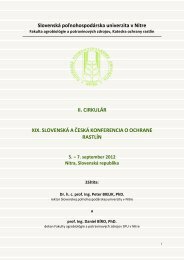00 ZLOM VURV 06 v roce 07
00 ZLOM VURV 06 v roce 07
00 ZLOM VURV 06 v roce 07
Create successful ePaper yourself
Turn your PDF publications into a flip-book with our unique Google optimized e-Paper software.
15<br />
of all available generatively propagated accessions<br />
which are documented in the network of institutions<br />
active within the Czech National Programme. Accessions<br />
are stored in 63,574 glass containers, another<br />
1,084 working collection samples and further 2,644<br />
safety duplication samples belonging to Research<br />
Institute of Plant Production in Pie‰Èany are kept in the<br />
gene bank storage. Altogether 77% of the total storage<br />
capacity in conditioned rooms is utilized.<br />
Samples are distributed to users according to their<br />
requests. In 2<strong>00</strong>6 in total 2,485 seed samples were delivered<br />
to 103 users.About 65% samples were addressed<br />
to domestic and 35% to foreign users.<br />
Documentation System<br />
The documentation system EVIGEZ has been further<br />
developed and frequently updated. The latest database<br />
consists of 49,<strong>06</strong>9 passport records representing all<br />
available accessions in Czech crop collections. About<br />
61.2% of these accessions are complemented by sets of<br />
characterization/evaluation data. Gene bank storage is<br />
fully documented in the system as well.<br />
The updated crop catalogue EVIGEZ containing<br />
passport data is on-line available to users on the URL:<br />
http://genbank.vurv.cz/genetic/resources/.<br />
Evaluation of wheat, winter barley, triticale, buckwheat<br />
and millet<br />
As agreed in the framework of the National Programme,<br />
the Department of Gene Bank of RICP is<br />
responsible for the evaluation of wheat, triticale, winter<br />
barley, wild relatives of crops of the tribe Triticeae, buckwheat,<br />
millet, Amaranthus, quinoa and further genetic<br />
resources of minor crops.<br />
In 2<strong>00</strong>6 the overwintering of winter wheat was at<br />
a very good level similarly like in the case of winter<br />
barley.The lodging of the two crops was also negligible<br />
in the last vegetation period. Owing to hot and dry<br />
weather during the grain filling period (July), wheat<br />
accessions originating from continental conditions<br />
were advantaged. High combined resistance to leaf,<br />
stem and stripe rusts were detected in cultivar ‘Bonito-<br />
27’ and advanced line ‘RU2-04’. Weather conditions<br />
during vegetation were suitable also for the winter<br />
barley check cultivar ‘Luran’. Among winter triticale<br />
accessions, the cultivar ‘SW Talentro’ was highly productive<br />
during the last two years of evaluation.<br />
The evaluation of wild relatives of crops of the tribe<br />
Triticeae indicated that Triticum boeoticum, T. araraticum,<br />
Aegilops geniculata and Ae. markgrafii had a good level of<br />
resistance to powdery mildew, stem and stripe rusts.<br />
Within a group of minor crops we evaluated<br />
134 genotypes of buckwheat, 22 accessions of millet,<br />
14 samples of Amaranthus and 5 foxtail millets.<br />
(Dotlaãil L., Stehno Z., Faberová I., Holubec V.,<br />
Dvofiáãek V., Janovská D., Pelichová E.)<br />
Study and utilisation of biodiversity, genetic<br />
mechanisms and new methods aimed at<br />
improvement of the biological potential<br />
of cultivars and sustainable development<br />
of agriculture (MZe âR <strong>00</strong>027<strong>00</strong>602)<br />
Phase 1: Study of genetic diversity in crops and<br />
its utilisation for sustainable development of<br />
agriculture; selection of donors of economically<br />
important characters to use them in research,<br />
breeding and practice<br />
Evaluation of prospective winter wheat genetic resources<br />
Prospective accessions of winter wheat genetic<br />
resources were evaluated for two years. The influence<br />
of growing conditions in the years of testing on overwintering<br />
was not strong (6.2%). On the other hand,<br />
the earliness (period to heading, flowering and waxy<br />
ripeness) was influenced markedly by different growing<br />
conditions (28.4, 65.2 and 30.4, respectively). The<br />
influence of the year on grain weight (TKW) was<br />
negligible (3.5%) similarly like on responses of wheat<br />
accessions to powdery mildew infection.<br />
Among grain quality parameters, crude protein<br />
content was highly influenced by growing conditions<br />
(24.4%) in comparison with the other quality<br />
characters with percentage not higher than 5.5%.<br />
Evaluation of winter barley cultivars<br />
Damage of barley accessions during the winter period<br />
was more serious than that of wheat. Some accessions<br />
Evaluation of wheat genetic resources




